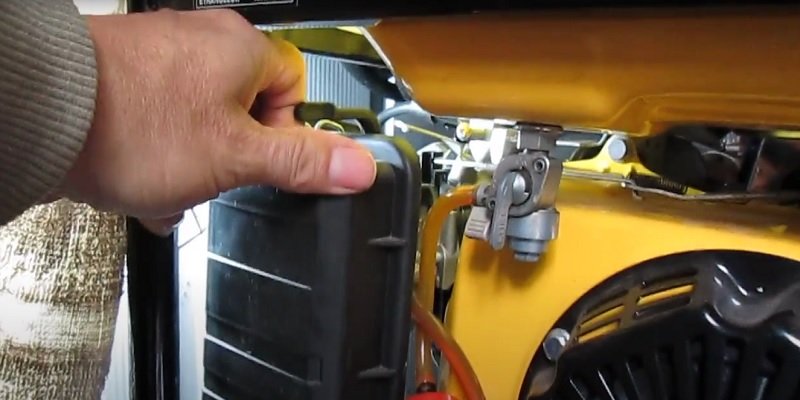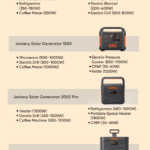Disclosure: This post contains affiliate links and I will be compensated if you make a purchase after clicking through my links. Learn More
A generator may sputter due to issues with its fuel supply or spark plug. When the fuel supply is inadequate or contaminated, it can lead to a sputtering generator.
Similarly, a faulty or dirty spark plug can result in irregular combustion, causing sputtering.
Common Causes Of Generator Sputtering
If you’ve ever experienced the frustrating issue of your generator sputtering, you know how disruptive and inconvenient it can be. A sputtering generator can lead to power fluctuations and even complete power outages, causing inconveniences and potentially jeopardizing your important electrical appliances. To help you diagnose and resolve this problem, we will discuss the most common causes of generator sputtering.
Dirty Or Clogged Fuel Filter
One prevalent cause of generator sputtering is a dirty or clogged fuel filter. Over time, fuel filters can become filled with debris, dirt, and contaminants that restrict the flow of fuel to the engine. When the fuel flow is obstructed, the generator may struggle to receive an adequate fuel supply, resulting in sputtering and inconsistent power output.
Regularly inspecting and maintaining the fuel filter is essential to prevent sputtering issues. If you notice signs of sputtering, consider cleaning or replacing the fuel filter promptly. This simple maintenance task can improve your generator’s performance and prevent further complications.

Fuel Contamination
Another possible cause of generator sputtering is fuel contamination. Over time, especially when generators are left unused for extended periods, the fuel can become stale and contaminated. This contamination may manifest in the form of water accumulation, rust, or the presence of sediment.
To avoid fuel contamination-related issues, it’s crucial to store fuel properly and use fuel stabilizers. Additionally, periodically draining the fuel tank and using only fresh, clean fuel can help prevent sputtering problems.
Faulty Spark Plug
A faulty spark plug is another common culprit behind generator sputtering. The spark plug is responsible for igniting the air-fuel mixture in the engine’s combustion chamber. When the spark plug is worn out, dirty, or damaged, it may fail to generate a strong spark, causing misfires and sputtering.
To resolve spark plug-related sputtering issues, inspect the condition of the spark plug regularly and replace it if necessary. Additionally, keeping the spark plug clean and properly gapped helps ensure optimal performance and reliable operation of your generator.
Low Oil Level In The Engine
A low oil level in the generator engine can also lead to sputtering problems. The oil lubricates and cools various engine components, including pistons, bearings, and valves. Without adequate oil, these essential parts may not function properly, causing sputtering and other performance issues.
Regularly checking the oil level in your generator and maintaining it at the recommended level is crucial. If you notice low oil levels, always refill the engine with the manufacturer-recommended oil type to prevent sputtering and potential engine damage.
In conclusion, generator sputtering can result from various issues, including dirty fuel filters, fuel contamination, faulty spark plugs, and low oil levels in the engine. Regular inspection, maintenance, and prompt resolution of these problems can help ensure the smooth operation and reliable performance of your generator.
Troubleshooting A Sputtering Generator
If your generator is sputtering, it can be both frustrating and concerning. A sputtering generator can lead to power fluctuations or even a complete shutdown, disrupting your daily activities. However, with a systematic approach and some troubleshooting steps, you can identify and resolve the underlying issues causing the sputtering. In this article, we will walk you through the step-by-step process of troubleshooting a sputtering generator.
Step 1: Checking The Fuel Filter
One of the common reasons for a sputtering generator is a clogged fuel filter. The fuel filter prevents dirt, debris, and other contaminants from entering the engine, ensuring a smooth fuel flow. However, over time, the filter can become clogged, restricting the fuel supply and causing the generator to sputter. To check the fuel filter:
- Locate the fuel filter on your generator. It is usually located near the fuel tank or on the fuel line.
- Inspect the filter for any signs of clogging, such as dirt, debris, or discoloration.
- If the filter appears dirty or clogged, it needs to be cleaned or replaced.
- Clean the filter by carefully removing it and using compressed air to blow away any debris. Alternatively, replace the filter with a new one if cleaning doesn’t resolve the issue.
Step 2: Inspecting The Fuel For Contamination
Contaminated fuel can also cause a generator to sputter. Impurities in the fuel, such as water or sediment, can disrupt the fuel combustion process and lead to an uneven engine performance. To inspect the fuel for contamination:
- Turn off the generator and let it cool down.
- Drain a small amount of fuel from the generator’s fuel tank into a clean, transparent container.
- Observe the fuel for any signs of water droplets or sediment at the bottom.
- If you notice any contamination, drain the entire fuel tank and refill it with fresh, clean fuel.
Step 3: Examining The Spark Plug
A faulty or worn-out spark plug can contribute to a sputtering generator. The spark plug ignites the fuel-air mixture inside the engine, creating the necessary combustion for power generation. A damaged spark plug can lead to incomplete combustion, resulting in a sputtering engine. Follow these steps to examine the spark plug:
- Locate the spark plug on your generator. It is typically situated near the engine’s cylinder head.
- Remove the spark plug using a spark plug wrench.
- Inspect the spark plug for any signs of damage, such as worn-out electrodes or deposits.
- If the spark plug appears damaged, replace it with a new one that matches the manufacturer’s specifications.
Step 4: Checking The Oil Level In The Engine
Inadequate oil level can also contribute to a sputtering generator. Insufficient lubrication can cause friction between moving parts, resulting in engine inefficiency and sputtering. To check the oil level in the engine:
- Ensure the generator is turned off and cooled down.
- Locate the oil dipstick, typically located near the engine.
- Remove the dipstick and wipe it clean with a cloth.
- Re-insert the dipstick into the oil reservoir and pull it out again to check the oil level.
- If the oil level is below the recommended level, add oil according to the manufacturer’s instructions.
By following these troubleshooting steps, you can identify and resolve the issues causing your generator to sputter. However, if the problem persists or you are uncertain about performing these steps yourself, it is advisable to seek professional assistance to ensure your generator operates optimally.
Fixing A Sputtering Generator
If your generator is sputtering, it can be quite frustrating, especially when you’re relying on it for power. However, there are several common issues that can cause a generator to sputter. In this section, we’ll discuss some of the most common problems and how to fix them:
Cleaning Or Replacing The Fuel Filter
Your generator’s fuel filter plays a vital role in ensuring clean fuel reaches the engine. Over time, the filter can become clogged with dirt, debris, and other contaminants. This can disrupt the fuel flow and lead to sputtering or engine stalling. Cleaning or replacing the fuel filter is a relatively simple task that can make a big difference in performance.
Treating Fuel Contamination
Contaminated fuel is another common culprit behind a sputtering generator. Fuel contamination can occur due to factors such as water condensation, dirt, or algae growth within the fuel tank. To treat fuel contamination, you can add a fuel treatment additive to remove water or use a fuel stabilizer to prevent algae growth. Treating fuel contamination will help restore smooth operation and prevent future issues.
Cleaning Or Replacing The Spark Plug
The spark plug is responsible for creating the spark that ignites the fuel-air mixture in the engine. If the spark plug becomes dirty or worn out, it can hinder proper combustion and cause sputtering. Cleaning the spark plug using a wire brush and making sure the electrode gap is within the manufacturer’s specifications can often resolve the issue. If the spark plug is severely damaged or worn, it’s recommended to replace it with a new one.
Topping Up The Oil Level In The Engine
Another potential cause of a sputtering generator is insufficient oil in the engine. Without proper lubrication, the engine can experience increased friction and overheating, leading to sputtering or even engine failure. Check the oil level regularly and add more oil if it is below the recommended level. Use the manufacturer’s recommended oil type to ensure optimal performance.
By addressing these common issues, you can significantly improve the performance of your sputtering generator. Regular maintenance and timely repairs will not only enhance its reliability but also extend its lifespan. Remember to consult your generator’s manual or seek professional assistance if you’re unsure about any specific maintenance task.
Preventive Maintenance For A Sputtering Generator
Regular maintenance is crucial to ensure the smooth functioning of your generator. One of the most common issues faced by generator owners is sputtering, which can lead to decreased performance and even breakdowns. However, with proper preventive maintenance, you can avoid these issues and keep your generator running efficiently for years to come. In this article, we will discuss some essential maintenance tasks you should perform to prevent your generator from sputtering.
Regularly Clean Or Replace The Fuel Filter
One of the main culprits behind a sputtering generator is a clogged fuel filter. Over time, the fuel filter can accumulate dirt, debris, and contaminants, hindering the fuel flow to the engine. To prevent this, it is crucial to regularly clean or replace the fuel filter.
If your generator has a replaceable fuel filter, check the manufacturer’s recommendations for the specific interval. Typically, fuel filters should be replaced every 100 hours of operation or at least once a year. Additionally, consider inspecting the filter regularly for any signs of debris accumulation or damage. If you notice any issues, clean or replace the filter immediately.
Ensure Clean And Quality Fuel
The quality of the fuel you use in your generator plays a significant role in its performance. Contaminated or stale fuel can lead to sputtering and poor combustion. To prevent this, follow these simple steps:
- Always use clean and fresh fuel from a reliable source. Avoid using fuel with visible impurities or water content.
- Consider using fuel stabilizers to prolong the shelf life of your fuel and prevent it from deteriorating over time.
- Regularly drain and replace the fuel in the generator’s tank to ensure freshness.
- If your generator will be stored for an extended period, it’s recommended to drain the fuel tank completely.
Regularly Clean Or Replace The Spark Plug
A faulty spark plug can lead to incomplete combustion and sputtering in your generator. Therefore, it is crucial to regularly clean or replace the spark plug to maintain optimal performance. Here’s how to do it:
- Start by disconnecting the spark plug wire.
- Clean the spark plug using a wire brush or replace it if it’s worn out or damaged.
- Ensure the spark plug gap is set according to the manufacturer’s specifications.
Perform Regular Oil Checks And Top-ups
The oil in your generator is essential for lubricating the engine and ensuring smooth operation. Regular oil checks and top-ups are crucial to prevent sputtering and engine damage. Here’s what you need to do:
- Refer to the manufacturer’s instructions to locate the oil dipstick and oil fill port.
- Check the oil level using the dipstick. If it’s below the recommended level, add the appropriate type and amount of oil.
- Make sure to use the recommended oil viscosity for your generator.
- Regularly change the oil based on the manufacturer’s recommendations or after a certain number of operating hours.
By following these preventive maintenance tips, you can keep your generator running smoothly and prevent sputtering issues. Taking the time to perform these tasks on a regular basis will not only prolong the life of your generator but also ensure its reliable performance when you need it the most.
Frequently Asked Questions Of Why Is My Generator Sputtering?
What To Do If Generator Is Sputtering?
To fix a sputtering generator, try the following steps: 1. Check fuel level and add more if needed. 2. Clean the fuel filter to remove any clogs. 3. Inspect and clean the spark plug for proper ignition. 4. Adjust the carburetor to ensure the right fuel-air mixture.
5. If the problem persists, consult a professional for further diagnosis and repairs.
Why Is My Generator Chugging?
Your generator may be chugging due to a clogged air or fuel filter, low oil level, or carburetor issues. Make sure to clean or replace filters, check the oil level, and have the carburetor inspected if needed. Regular maintenance can prevent chugging and ensure smooth generator performance.
What Causes A Generator Not To Run Smoothly?
Possible reasons for a generator not running smoothly could include fuel issues, such as contaminated fuel or insufficient fuel supply, as well as problems with the ignition system, spark plugs, or carburetor. Other potential factors may include a clogged air filter, low oil levels, or a malfunctioning engine.
Why Is My Generator Running Rough And Shaking?
A generator may run rough and shake if there is a problem with its fuel supply, spark plug, or air filter. It could also be due to a malfunctioning carburetor or engine compression issues. Regular maintenance and addressing these issues can help resolve the problem and ensure smooth operation of your generator.
Final Words
To conclude, if you find that your generator is sputtering, it is important to address the issue promptly. By understanding the potential causes such as fuel issues, carburetor problems, or ignition system malfunctions, you can troubleshoot and rectify the problem effectively.
Regular maintenance and proper usage of the generator can also help prevent sputtering in the long run. Remember, a smooth-running generator ensures uninterrupted power supply during emergencies and outdoor activities.








